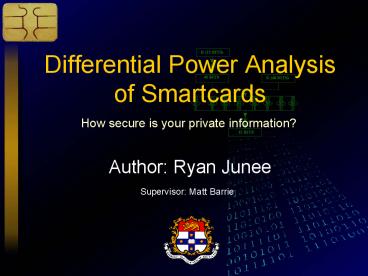Differential Power Analysis of Smartcards PowerPoint PPT Presentation
1 / 12
Title: Differential Power Analysis of Smartcards
1
Differential Power Analysis of Smartcards
- How secure is your private information?
Author Ryan Junee
Supervisor Matt Barrie
2
1. Project Goals
- To illustrate a dangerous weakness in
cryptographic smartcards and microprocessors -
private information can be leaked through power
usage (and other side channels). - Construct a system to acquire a large number of
power traces from a smartcard or microprocessor. - Analyse captured power traces and search for
leaked information. - Recover secret key information from a smartcard
or microprocessor. - Suggest ways of preventing such power analysis
attacks. - Discuss legal, political and commercial
ramifications of this work.
3
2. Smartcard Technology
- Several varieties of smartcards exist
- Simple memory cards
- Cards with a microprocessor and file system
- Cards with a cryptographic coprocessor
- Even cards that run a Java virtual machine
- Smartcards run an operating system that may allow
additional programs to be loaded on to the card.
The two most widely used operating systems are
MULTOS and JavaCard. - Smartcards conform to the ISO7816 standard which
specifies physical and electrical
characteristics. - Other high level standards exist such as EMV
which covers smartcards used in payment systems.
4
3. Smartcard Applications
- Smartcards have been used overseas for many years
(especially in Europe), for applications such as
healthcare and transport ticketing.
- Smartcard usage is growing, recent applications
include - Credit cards and payment systems (ANZ First,
American Express Blue etc). - Personal identity cards SMARTICS is currently
being rolled out in Hong Kong, every citizen will
be issued with a card containing identity
information, and third party data. - Phone cards, building access cards, computer
access cards
5
4. Power Analysis Attacks
- Microprocessor-based devices, such as smartcards,
consume different amounts of power depending on
the instructions executed. - This is due to the switching current drawn by the
transistors along the logic path of each
instruction. - It is possible to discover the algorithms used
inside smartcards by examining power traces
(Simple Power Analysis). - More sophisticated statistical techniques exist
that can
recover secret key material from
cryptographic smartcards (Differential Power
Analysis).
6
5. Example DES Encryption
- Many cryptographic smartcards use the DES
encryption algorithm to securely store sensitive
information. - DES takes a 64-bit plaintext input and a 56-bit
key, and produces a 64-bit ciphertext output.
- The algorithm performs an initial permutation of
the plaintext, followed by 16 feistel rounds, and
finally an inverse permutation to produce the
ciphertext. - We observe the encryption operation to try and
discover the secret key.
7
6. Equipment Setup
- For demonstration purposes, a PIC microprocessor
is examined as it allows direct access to the
source code. - Smartcards use general purpose microprocessors so
the results shown here also apply to smartcards.
Computer controls CRO and stores acquired
waveforms
PIC running DES encryptions
High Precision CRO
8
7. Simple Power Analysis
- A single power trace shows some characteristics
of the algorithm. - DES rounds are not easily observable at this
macro level.
9
8. Simple Power Analysis
- Zooming in on a single DES round, the algorithm
is now readily observable. - Thus SPA can be used to discover the hidden
implementation details of smartcards and other
microprocessor-based devices.
10
9. Differential Power Analysis
Differential trace of two encryptions with the
same key
Two encryptions with a different key (one bit
different)
- The effect of an individual key bit can be
observed in a differential trace. Several
regular peaks are visible at the start, large
peaks are visible at the end.
11
10. Commercial Ramifications
- Given that information is leaked through power
analysis, smartcards can NOT be assumed safe and
tamper resistant. - It is not recommended that smartcards be used in
applications that require high security, such as
banking, personal identification, building
security etc. - Recent smartcards are addressing the problem of
power analysis attacks and implement protection
measures. It has not yet been ascertained if
these measures are sufficient.
12
11. Conclusions
- Simple power analysis can be used to identify
macro characteristics of algorithms used within
smartcards and microprocessors. This allows
discovery of hidden implementation details, and
reverse engineering. - Differential power analysis can be used to
recover specific information such as the
individual bits in a secret key. - Specific protection measures must be implemented
in all new smartcards, to ensure that information
is not leaked via power consumption and other
side channels.

